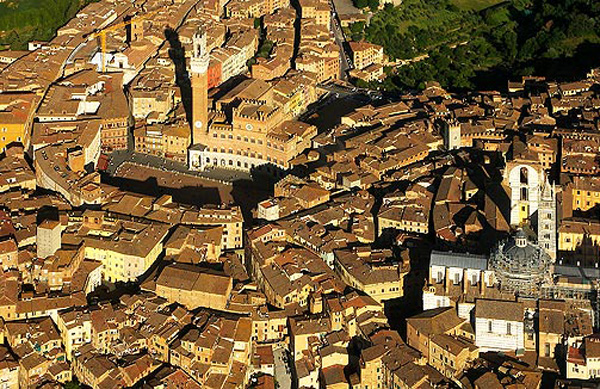Late Renaissance
Here Be Dragons! A Wrought Iron Sienese Dragon
A fierce wrought iron dragon from the Renaissance city of Siena, Italy, thought to be a pole or tethering ring.
By Judith Finlay
The museum register entry for the object reads:
“Pole-Ring (Cerchio Bracciale) from the front of a house in Siena, wrought iron; in the form of a dragon with extended wings. Italian. (DM:1902.489)”
This fierce dragon, just 19”/48cm in height, identified as late Renaissance, a vibrant and important time in art history (c. 1500 to 1600 AD). This beautiful creature is depicted with chest expanded, wings wide and neck curled down, mouth open and tongue out, challenging the onlooker.
It was made from a single sculpted wrought iron bar and has a twisted wrought iron ring at its base. The front and wings are sheet-cut and attached midway by two pins held at the rear. Two decorative roundels support the piece as fixing, with the smaller attached by a chain-linked collar. The thick bar on the reverse is designed to be embedded into architectural masonry.
Figure 2: Side view of Sienese dragon (DM:1902.489).
Wrought iron literally means ‘worked’ iron. It’s a type of iron with low carbon content. It is tough but easy to shape and weld. This makes it ideal for intricate designs such as this miniature, mighty dragon.
Where did it come from?
Siena is a central-Italian UNESCO World Heritage city in the Tuscan hills, most famous for its beautifully preserved medieval cityscapes. There are 17 ‘contrade di Siena’ within this city today. Contrade are city neighbourhoods, or wards, originally formed as battalions for the city’s defence. Each contrade has an animal as its emblem or mascot, and a particular set of colours to compliment it

Figure 3: Aerial view of Siena, Italy.
It is possible that this dragon comes from the Drago (dragon) contrade, in the north-west of the Piazza del Campo – the main public space at Siena’s historic centre.
What was it used for?
The dragon may once have held a flag pole in place, flying the colours of the Drago contrade during ceremonies and special occasions.
However, the Museum register (written when this object was purchased in 1902) describes it as a CerchioBracciale, which translates as ‘round bracelet’. This may also mean it was used as a rein or tethering ring. These rings are found throughout Siena’s main squares, used to tie horses in place around the city. A lot of the rein rings still found in Siena are similar to our dragon, particularly in the Drago contrade.
Figure 4: Front chest plate of Sienese dragon (DM:1902.489).
What meanings did dragon imagery portray?
Dragons appear in legends and folk stories around the world, from the dragons depicted on Agamenon’s armour in the ‘Iliad’ of ancient Greek mythology, to artefacts found in China from the 16th Century BC Shang dynasty. Asian dragons are usually calm and wise representing nature, strength and good luck, whereas their European counterparts are usually far more fierce creatures with war-like tendencies, though both symbolise longevity and intelligence. They were often depicted on maps to signify unexplored and potentially dangerous areas, and they have even been credited with teaching mankind how to speak.
Figure 5: Full dragon from the side (DM:1902.489).
This particular dragon is distinctively European because of the bat-like wings growing from the back. Ancient dragons were depicted without legs, resembling serpents, but by the time of the Renaissance dragons usually had legs and began to look more like lizards, making this example interesting for its time!
Learn more...
This iron dragon is not on public display as it is part of the museum’s reserve collections. You can see more examples from the Metalwork collection at our What’s In Store? exhibition, in the National Museum of Ireland - Decorative Arts and History.
References
Bayer, Andrea (ed.) (2008) Art and Love in Renaissance Italy, The Metropolitan Museum of Art, New York.
Jones, David E. (2002). An Instinct for Dragons, Routledge.
Kuehn, Sara (2011). The Dragon in Medieval East Christian and Islamic Art, Brill.
Nevola, Fabrizio (2007). Siena: Constructing the Renaissance City, Yale University Press.
Dragons have appeared in many great stories, all well worth reading:
Beowulf - an Old English epic
Sir Gawain and the Green Knight - a 14th century tale of chivalry and honour
William Morris’ The Story of Sigurd the Volsung and The Fall of the Niblungs
J.R.R. Tolkein’s The Hobbit and Lord of the Rings
*Many thanks to Hannah Power, Conservator, for her assistance with this article.
Suíomh:
Here Be Dragons! A Wrought Iron Sienese Dragon suite ag:
In Storage
An déantán roimhe seo:
Greek Porphyry from Viking Dublin
An chéad déantán eile:
